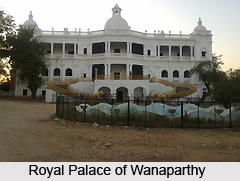 Wanaparthy is now the municipal town in Mahbubnagar district of Telangana, a newly formed state of India with Hyderabad its capital for ten years.
Wanaparthy is now the municipal town in Mahbubnagar district of Telangana, a newly formed state of India with Hyderabad its capital for ten years.
Wanaparthy, the census town of Mahbubnagar district of Telangana covers an area of about 27.34 square miles. Wanaparthy has the historical importance of the medieval and modern ages. During the rule of British Empire in India, the Nizams of Hyderabad ruled this place with the help of some feudal lords. The local feudal lord used to govern this place to collect the taxes from the farmers and peasants.
Wanaparthy was governed by a feudal ruler, Raja of Wanaparthy, Raja Rameshwar Rao II. He was a vassal or the feudal lord of the Nizam of Hyderabad. Wanaparthy was one of the 14 major Zamindari segments in Telangana in Post-Independent India.
Raja of Wanaparthy, Raja Rameshwar Rao II died on November 22, 1922 and his successor, Krishna Dev was a minor, so his estate was managed by the Court as his ward. Krishna Dev expired before attaining adulthood and the crown passed on to his another son Rameshwar Rao III. After the abolition of Zamindari system in India, the glory of Raja of Wanaparthy began to fade.
According to the Population Census of India that was conducted in the year 2011, the town of Wanaparthy had a population of 60,949. The total population constitute 31,501 males, 29,448 females and 6,122 children, in the age group of 0–6 years. The average literacy rate of Wanaparthy stands at 77.91 percent with 42,713 literates, significantly higher than the national average of 73.00 percent.
Wanaparthy has the historical tourism importance for the royal palaces of the feudal lords, who was directly under the rule of Nizams of Hyderabad. The major tourist attraction of the census town of Wanaparthy is Wanaparthy Samsthanam`s Palace. This palace shows the British- Mughal architectural and South Indian architectural styles. Wanaparthy Samsthanam traces its history back to 14th century that is from the early phase of medieval rule after the decline of Kakatiya kingdom. The successive Muslim rulers found it ideal for Samsthanam to prevail. It was surrounded by three other Samsthanam.



















